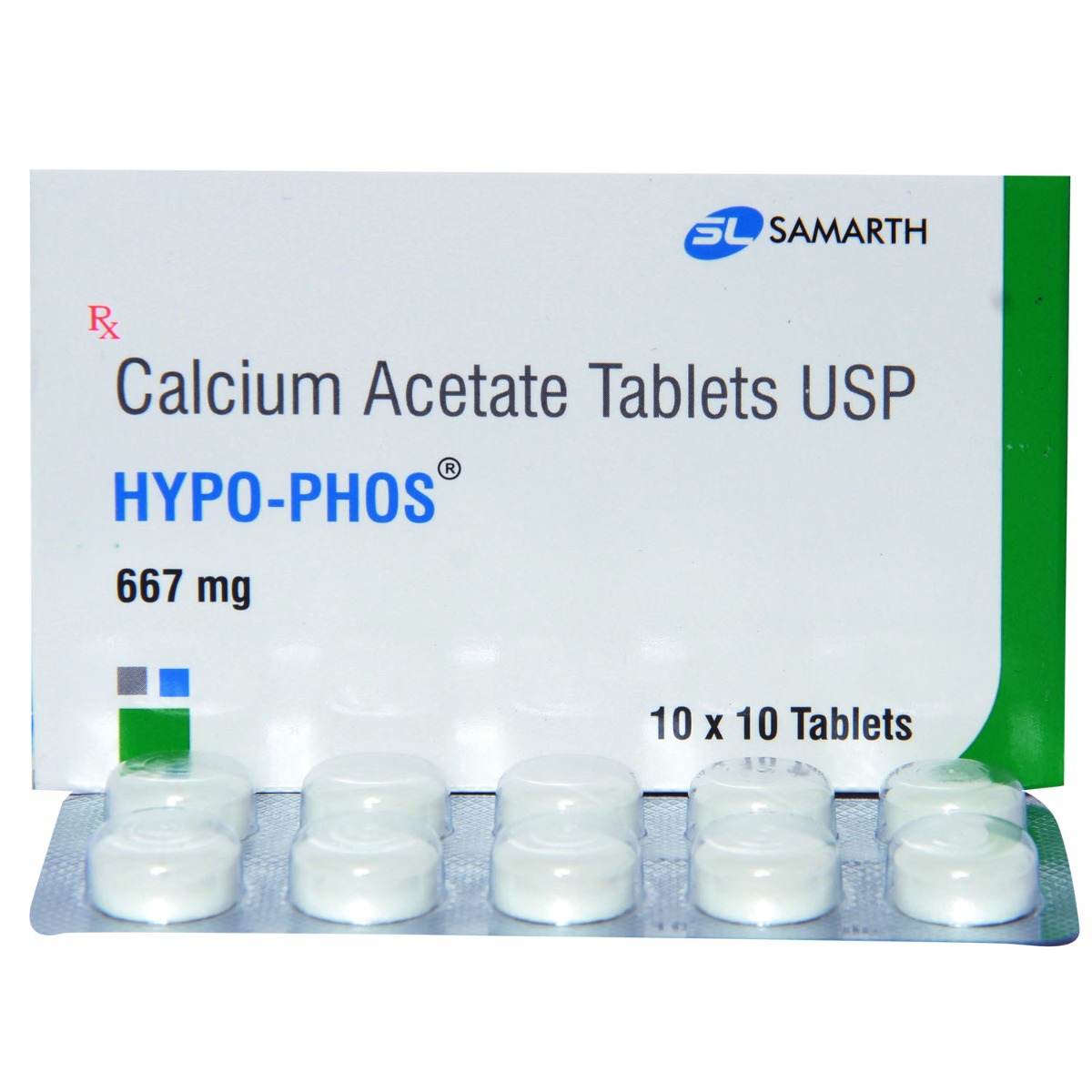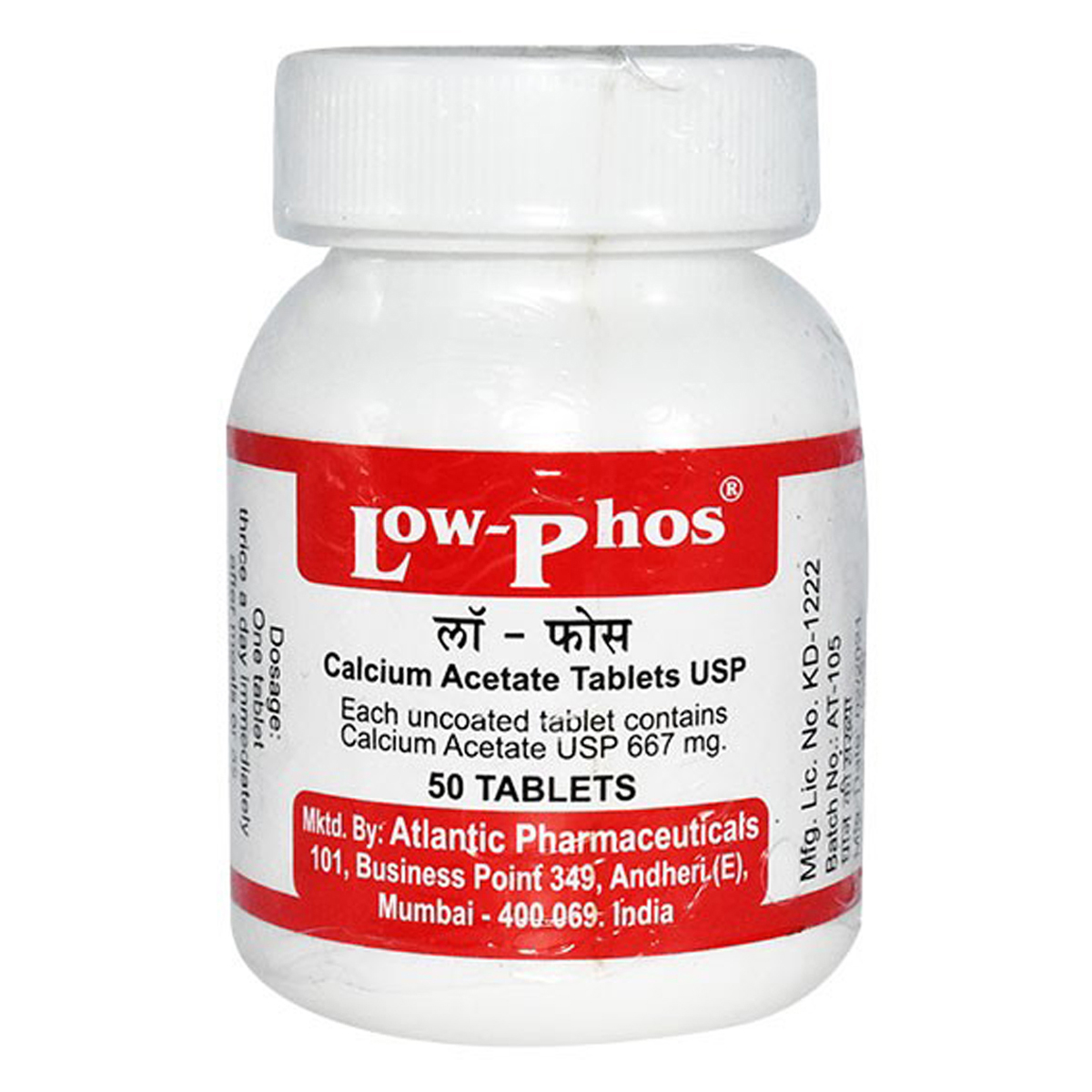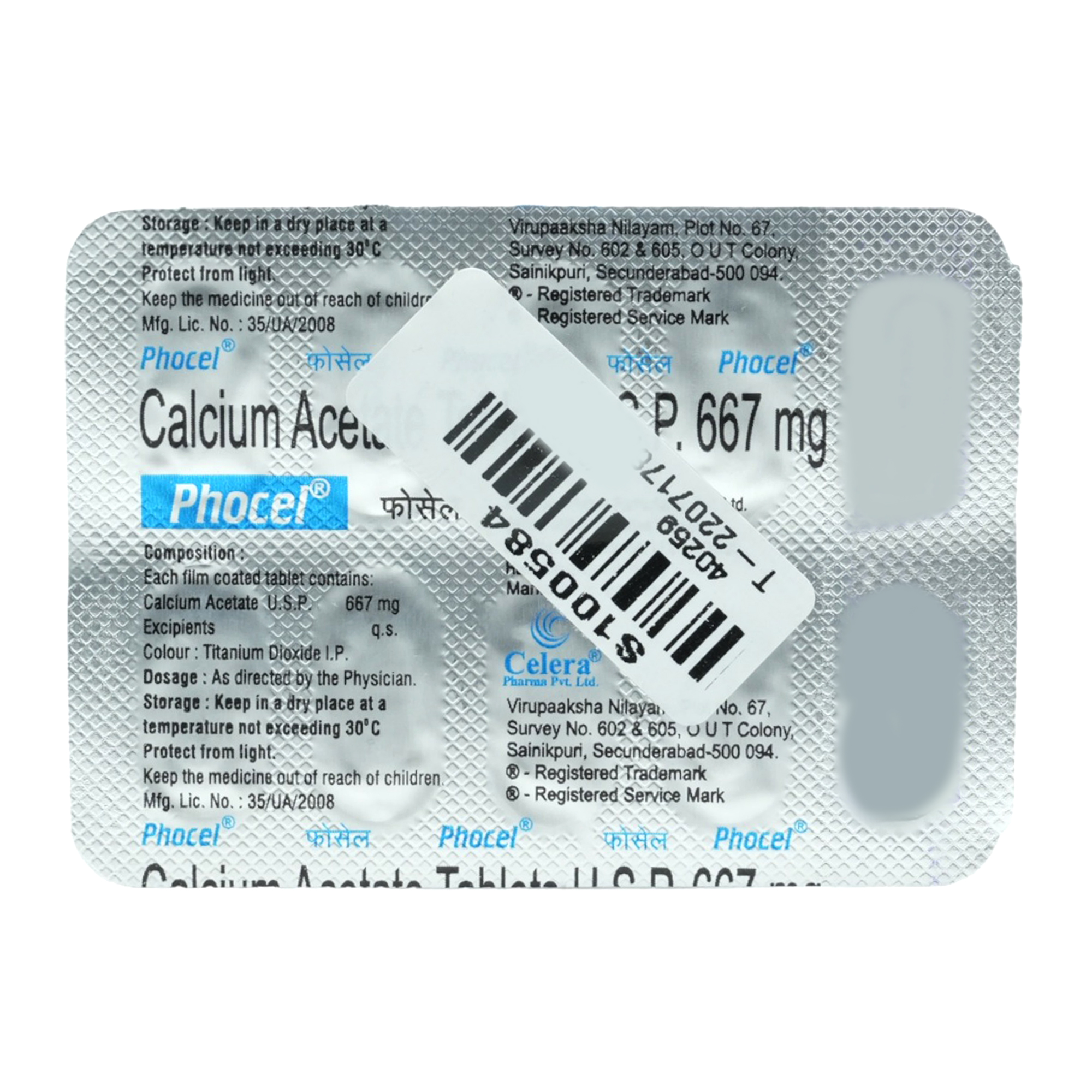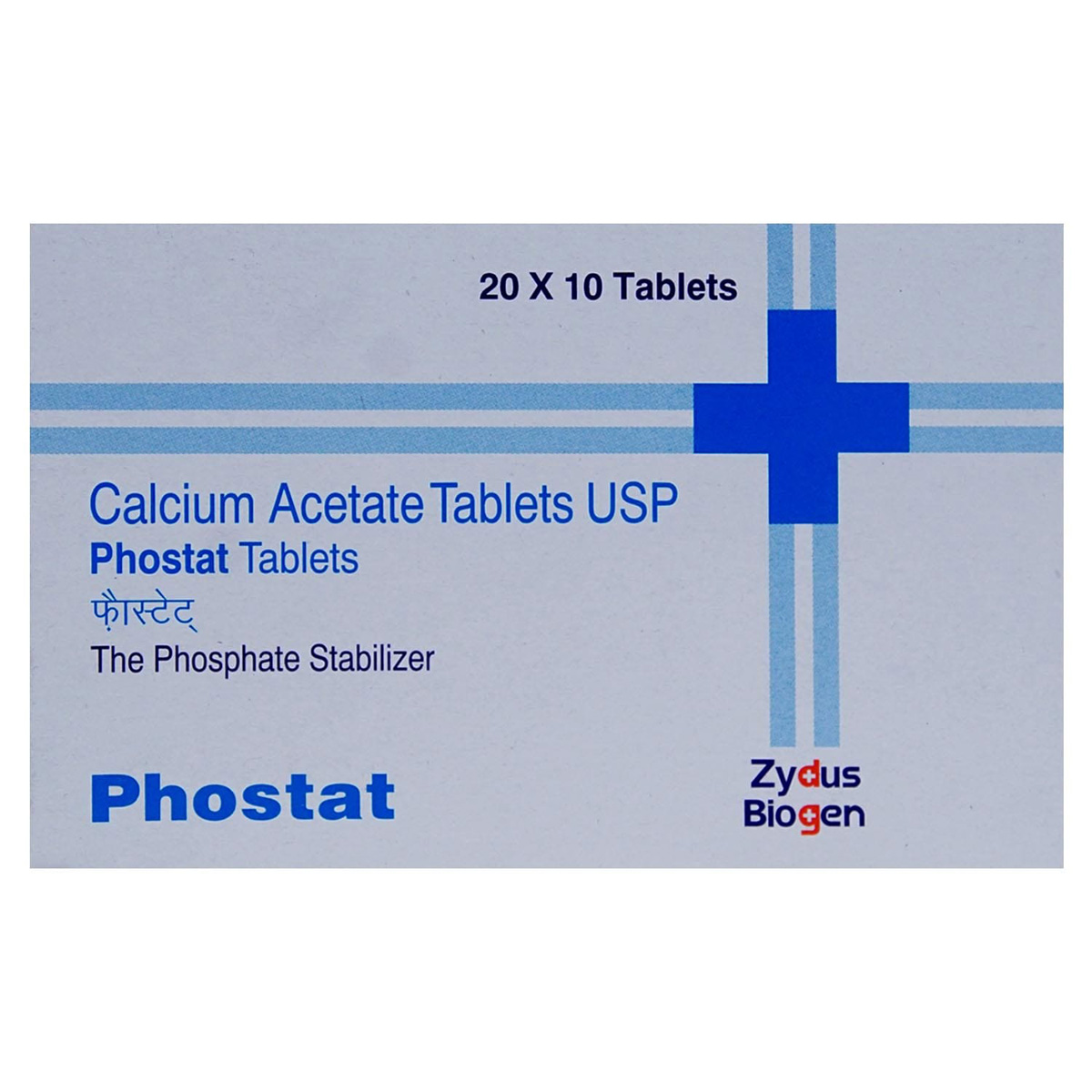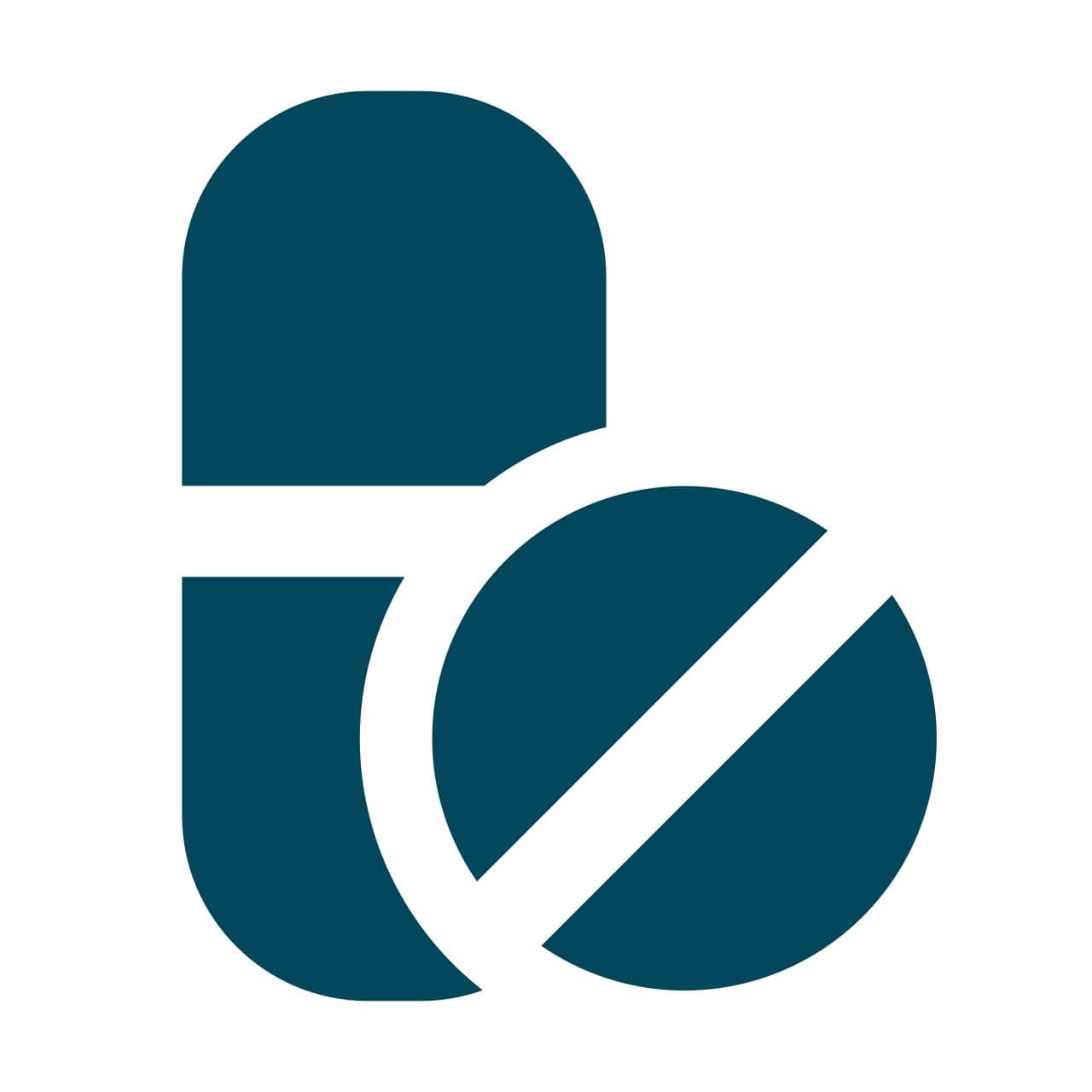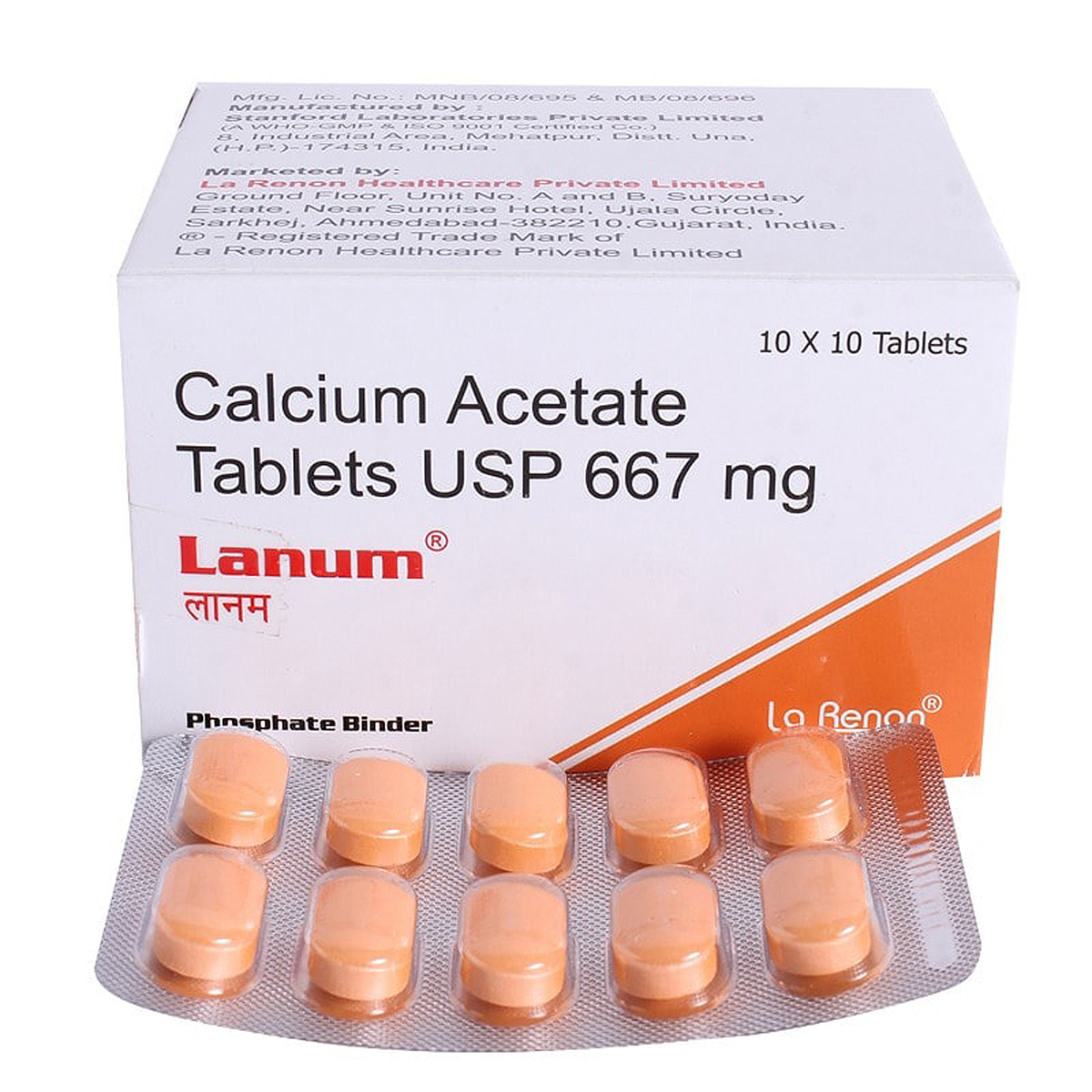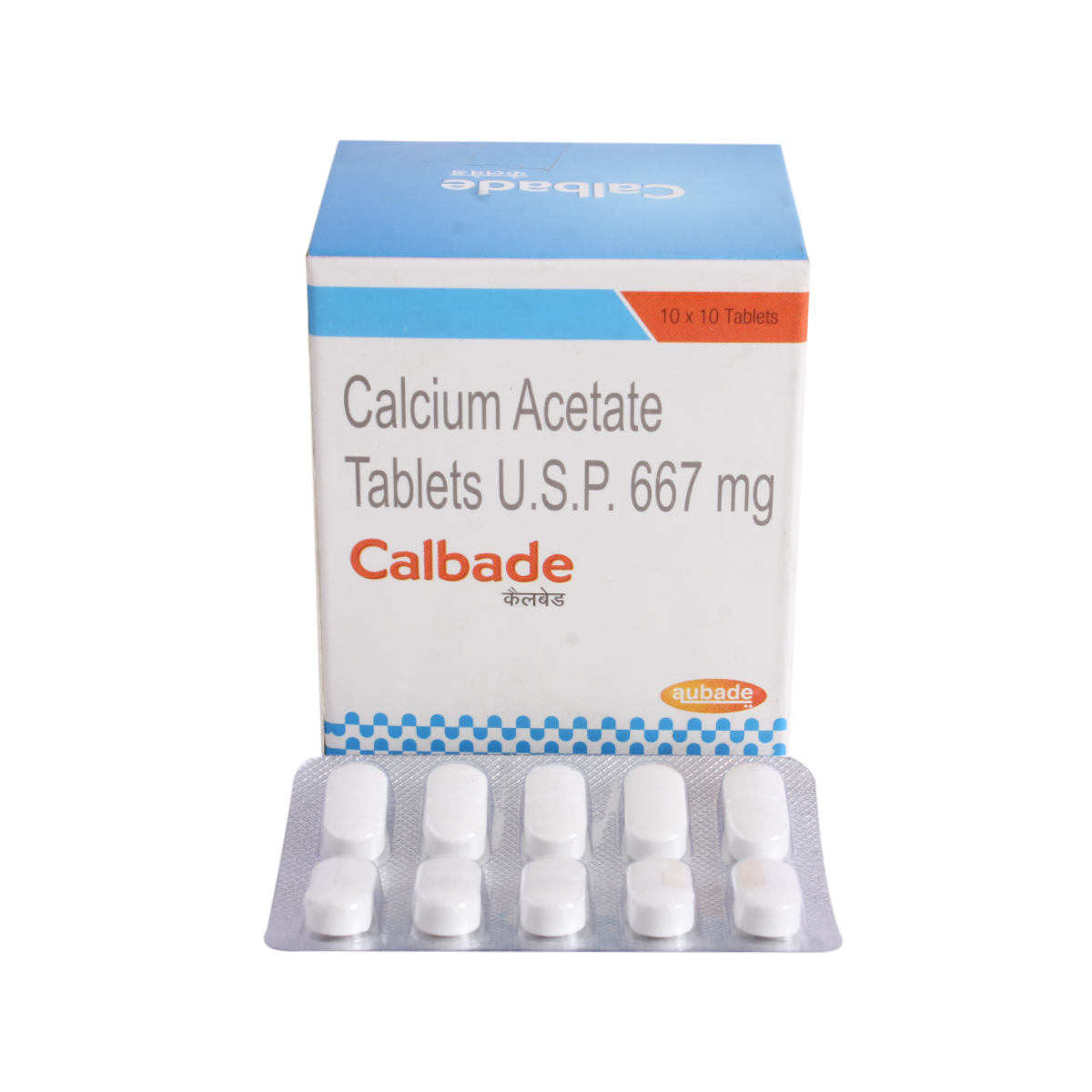Calcibind Tablet

MRP ₹48.5
(Inclusive of all Taxes)
₹6.6 Cashback (14%)
know your delivery time
Provide Delivery Location
Composition :
Manufacturer/Marketer :
Consume Type :
Return Policy :
Expires on or after :

Secure Payment

Trusted by 8 Crore Indians

Genuine Products
Therapeutic Class
Country of origin
Manufacturer/Marketer address
Author Details
We provide you with authentic, trustworthy and relevant information
FAQs
Calcibind Tablet controls the phosphate levels by removing phosphate from the food in your stomach before it gets into the bloodstream. Thus, it helps to prevent the high levels of phosphate in the bloodstream.
High phosphorus often does not cause symptoms itself. However, excess phosphorus in your blood can remove calcium from your bones and other body parts, resulting in low calcium (hypocalcemia). Low calcium causes symptoms such as muscle cramps, bone and joint discomfort, weak bones, and itchy skin or rash.
It is not recommended for use if you are allergic to any components present in Calcibind Tablet , if you have high levels of calcium in your blood or urine, or if you have low levels of phosphate in your blood.
Doctors will test your blood phosphate level to see if you have excess phosphorus. If your phosphate level is higher than 4.5 mg/dL, your doctor may order additional tests to rule out kidney disease.
Disclaimer
Alcohol
Caution
Avoid the consumption of alcohol as it may cause some side effects and make Calcibind Tablet less effective.
Pregnancy
Caution
Calcibind Tablet should not be used in pregnancy unless clearly necessary. So, inform your doctor if you are pregnant or suspect pregnancy. Your doctor will weigh the benefits and potential risks before prescribing Calcibind Tablet .
Breast Feeding
Caution
Calcibind Tablet should not be used in nursing mothers unless clearly necessary. Inform your doctor if you are breastfeeding. Your doctor will weigh the benefits and potential risks before prescribing Calcibind Tablet .
Driving
Not applicable
Calcibind Tablet does not affect your ability to drive or operate machinery.
Liver
Caution
If you have liver problems, inform your doctor before taking Calcibind Tablet . Your doctor may adjust the dose of this medicine based on your condition.
Kidney
Caution
If you have a pre-existing or a history of kidney condition, inform your doctor before taking Calcibind Tablet . Your doctor may adjust the dose of this medicine based on your condition.
Children
Consult your doctor
Safety and effectiveness in pediatric patients have not been established. Please consult your doctor.
Product Substitutes
Reference
- https://www.kidneyfund.org/living-kidney-disease/health-problems-caused-kidney-disease/high-phosphorus-hyperphosphatemia#:~:text=High%20phosphorus%2C%20also%20called%20hyperphosphatemia,2.5%20to%204.5%20mg%2FdL.
- https://www.drugs.com/drug-interactions/calcium-acetate.html
- https://medlineplus.gov/druginfo/meds/a620017.html
- https://www.accessdata.fda.gov/drugsatfda_docs/label/2011/021160s015lbl.pdf
- https://www.hpra.ie/img/uploaded/swedocuments/f1814b11-8a2c-41e0-95a1-7de958a5d7f4.pdf
About Calcibind Tablet
Calcibind Tablet belongs to the class of medicines known as phosphate binders. It is used to control high blood levels of phosphorus in people with kidney disease who are on dialysis (medical treatment to clean the blood when the kidneys are not working properly). High phosphorus, also called hyperphosphatemia, means you have extra phosphorus in your blood.
Calcibind Tablet contains calcium acetate, which works by binding phosphorus that you get from foods in your diet and prevents it from being absorbed into your bloodstream.
Use Calcibind Tablet as advised by your doctor. You may experience nausea (feeling sick) or vomiting (being sick), constipation and diarrhoea. Most of these side effects do not require medical attention and gradually resolve over time. However, if the side effects persist, contact your doctor.
Before taking Calcibind Tablet , let your doctor know if you are allergic to any ingredient of it. Inform your doctor before taking Calcibind Tablet if you are pregnant, planning to become pregnant, or breastfeeding if you have lactose intolerance, have high levels of calcium in your blood or urine, or have low levels of phosphate in your blood. It is recommended not to consume alcohol while on treatment with this medicine. Inform your doctor about your medical history and other medications you are currently taking to rule out any potential negative effects.
Uses of Calcibind Tablet
Medicinal Benefits Mweb
Medicinal Benefits
Calcibind Tablet belongs to the class of medicines known as phosphate binders. It contains calcium acetate. It is commonly used to treat kidney failure in individuals undergoing regular haemodialysis or continuous ambulatory peritoneal dialysis (CAPD). In kidney failure, the phosphate levels in the blood can be high. Calcibind Tablet controls the phosphate levels by removing phosphate from the food in your stomach before it enters the bloodstream. Thus, it helps to prevent the high phosphate levels in the stream.
Directions for Use
Side Effects of Calcibind Tablet
- Nausea (feeling sick)
- Vomiting (being sick)
- Constipation
- Diarrhoea
- Rash
Drug Warnings
Before taking the Calcibind Tablet , inform your doctor if you are allergic to any of its ingredients. If you are pregnant, planning to become pregnant, or breastfeeding, or if you have high levels of calcium in your blood or urine or low levels of phosphate in your blood. Long-term high calcium levels in your blood may lead to a build-up of calcium in your blood vessels or soft tissues. Your blood calcium levels will be checked on a regular basis by your doctor. If your levels are too high, your dose will be lowered, or your therapy will be stopped immediately. Other medications, especially antibiotics (such as norfloxacin, ciprofloxacin, or tetracyclines), diuretics (such as thiazides), and bisphosphonates (used to treat bone problems), should not be taken with Calcibind Tablet unless prescribed by a doctor.
Drug-Drug Interactions
Drug-Drug Interactions
Login/Sign Up
Calcibind Tablet may interfere with the absorption of lymecycline and reduce its effectiveness.
How to manage the interaction:
Calcibind Tablet may interfere with the absorption of lymecycline and reduce its effectiveness. Although there is an interaction, Calcibind Tablet can be taken with lymecycline if prescribed by the doctor.
Co-administration of Dolutegravir with Calcibind Tablet can reduce the effectiveness of dolutegravir.
How to manage the interaction:
Taking Dolutegravir with Calcibind Tablet together can possibly result in an interaction, they can be taken together if prescribed by your doctor. It is recommended to take dolutegravir at least two hours before or six hours after the Calcibind Tablet dose. Do not discontinue any medications without consulting a doctor.
Co-administration of Calcibind Tablet may interfere with the absorption of Demeclocycline and reduce its effectiveness.
How to manage the interaction:
Taking Calcibind Tablet may interfere with the absorption of Demeclocycline and reduce its effectiveness. Therefore, Calcibind Tablet and demeclocycline should not be taken orally at the same time. Maintaining a gap of 2-4 hours between both medicines is advised. Do not discontinue the medication without consulting a doctor.
Co-administration of Oxytetracycline when taken along with Calcibind Tablet lowers the levels of either medication. This interaction applies to the oral forms of both medications.
How to manage the interaction:
Although taking Oxytetracycline and Calcibind Tablet together can result in an interaction, it can be taken if a doctor has prescribed it. Do not stop using any medications without talking to a doctor.
Co-administration of doxycycline with Calcibind Tablet can reduce its effectiveness.
How to manage the interaction:
Although there is an interaction between Calcibind Tablet and doxycycline, it can be taken together if prescribed by a doctor. It is adviced to take doxycycline 2 hrs before or 6 hours after taking Calcibind Tablet. Do not stop using any medications without talking to a doctor.
Drug-Food Interactions
Drug-Food Interactions
Login/Sign Up
Drug-Diseases Interactions
Drug-Diseases Interactions
Login/Sign Up
Increased serum calcium and phosphate levels that are greater than the solubility limit can cause calcium-phosphate precipitates to form in the body's vascular and renal systems as well as other soft tissues.
How to manage the interaction:
Therapy with Calcibind Tablet should be administered with extreme caution in patients with hyperphosphatemia (high phosphate in blood).
The contraction of heart muscle and the transmission of electrical impulses both include calcium. Patients with heart illness should receive therapy with calcium salt formulations (especially IV) with caution.
How to manage the interaction:
Therapy with Calcibind Tablet (particularly IV) should be administered cautiously to patients with cardiac disease.
Active transport and passive diffusion are both used to absorb calcium from the gastrointestinal system.
How to manage the interaction:
Malabsorption may decrease the absorption of Calcibind Tablet.
Patients with sarcoidosis may occasionally experience hypercalciuria, with or without hypercalcemia.
How to manage the interaction:
Hypercalciuria (excessive urinary calcium excretion), with or without hypercalcemia (high calcium levels), may occasionally occur in patients with sarcoidosis. Therapy with Calcibind Tablet should be administered cautiously and only if necessary in patients with sarcoidosis.
Drug-Drug Interactions Checker List
- NORFLOXACIN
- CIPROFLOXACIN
- HYDROCHLOROTHIAZIDE
- CHLORTHALIDONE
- ALENDRONATE
- RISEDRONATE
Habit Forming
Special Advise
To rule out the possibility of electrolyte imbalance, electrolyte levels should be monitored on a regular basis.
Diet & Lifestyle Advise
- Maintain a well-balanced and healthy diet.
- Keep your weight under control with a BMI of 19.5-24.9
- Eat low-phosphorus foods such as sourdough bread, corn or rice cereals, cream of wheat, unsalted popcorn and some light-coloured sodas & lemonade.
- Avoid high-phosphorus foods, including bran cereals, oatmeal, nuts, sunflower seeds, whole-grain bread and dark-coloured colas.
- Limit or avoid alcohol consumption.
- Quitting smoking is the best strategy to lower the risk of illness.

Have a query?
Buy best Health & Nutrition products by
Vlado Sky Enterprise Pvt Ltd
Abbott India Ltd
Sun Pharmaceutical Industries Ltd
Apollo Healthco Limited
Zydus Healthcare Ltd
Macleods Pharmaceuticals Ltd
West Coast Pharmaceuticals Pvt Ltd
Intas Pharmaceuticals Ltd
Mankind Pharma Pvt Ltd
Meyer Organics Pvt Ltd
Emcure Pharmaceuticals Ltd
Lupin Ltd
Alkem Laboratories Ltd
Nutritionalab Pvt Ltd
Eris Life Sciences Ltd
Akumentis Healthcare Ltd
British Biologicals
La Renon Healthcare Pvt Ltd
Cipla Ltd
Micro Labs Ltd
Zuventus Healthcare Ltd
Torrent Pharmaceuticals Ltd
Pharmed Ltd
Dr Reddy's Laboratories Ltd
Modi Mundipharma Pvt Ltd
Corona Remedies Pvt Ltd
Hindustan Unilever Ltd
Indchemie Health Specialities Pvt Ltd
Apex Laboratories Pvt Ltd
Koye Pharmaceuticals Pvt Ltd
Leeford Healthcare Ltd
Bioceutics Inc
East West Pharma India Pvt Ltd
Alniche Life Sciences Pvt Ltd
FDC Ltd
Alembic Pharmaceuticals Ltd
Aristo Pharmaceuticals Pvt Ltd
DR Johns Lab Pharma Pvt Ltd
Herbs Nutriproducts Pvt Ltd
Guardian Healthcare Services Pvt Ltd
Vasu Organics Pvt Ltd
Pulse Pharmaceuticals
Fourrts India Laboratories Pvt Ltd
TTK Healthcare Ltd
Raptakos Brett & Co Ltd
USV Pvt Ltd
Glanbia Performance Nutrition India Pvt Ltd
Morepen Laboratories Ltd
Innovcare Life Sciences Pvt Ltd
Linux Laboratories Pvt Ltd
Troikaa Pharmaceuticals Ltd
Cadila Pharmaceuticals Ltd
Bright Lifecare Pvt Ltd
Wockhardt Ltd
Sanofi India Ltd
Primus Remedies Pvt Ltd
Zydus Cadila
Kellogg India Pvt Ltd
Tablets India Ltd
Indoco Remedies Ltd
Medley Pharmaceuticals Ltd
Overseas Health Care Pvt Ltd
Procter & Gamble Health Ltd
Shri Balaji Overseas
Dabur India Ltd
Ordain Health Care Global Pvt Ltd
Systopic Laboratories Pvt Ltd
Ajanta Pharma Ltd
Daris Biocare
Health & Happiness (H&H) Trading India Pvt Ltd
Hexagon Nutrition Pvt Ltd
Nutricia International Pvt Ltd
Zee Laboratories Ltd
Aareen Healthcare Pvt Ltd
Aeronutrix Sports Products Pvt Ltd
Emami Ltd
Radicool Pharmaceuticals Pvt Ltd
Wanbury Ltd
Biovitamins Pvt Ltd
Cadila Healthcare Ltd
Esmatrix Life Sciences Pvt Ltd
Ipca Laboratories Ltd
Klm Laboratories Pvt Ltd
Lloyd Healthcare Pvt Ltd
Sain Medicaments Pvt Ltd
Septalyst Lifesciences Pvt Ltd
Tas Med India Pvt Ltd
Wallace Pharmaceuticals Pvt Ltd
Biorex Healthcare Pvt Ltd
Elbrit Life Sciences Pvt Ltd
Levin Life Sciences Pvt Ltd
Panacea Biotec Ltd
Adret Retail Pvt Ltd
Cipla Health Ltd
Delcure Life Sciences Ltd
Femura Pharmaceuticals Pvt Ltd
Gladstone Pharma India Pvt Ltd
GlaxoSmithKline Consumer Healthcare Ltd
Kepler Healthcare Pvt Ltd
Ronyd Healthcare Pvt Ltd
SPECIALITY SUPPLEMENT
CALCIUM
IRON
VITAMIN D
COLLAGEN
VITAMIN B12
VITAMIN C
FISH OIL OMEGA
VITAMIN B
MULTIVITAMIN
Adult Nutrition Drink
ZINC
SEXUAL HEALTH SUPPLEMENT
WHEY PROTEIN
Kids Nutrition Drink
VITAMIN B9
ENERGY DRINK
SPECIALITY NUTRITION DRINK
DRY FRUIT
HERBAL JUICE
VITAMIN E
Prebiotic & Probiotic
ORS
SUGAR SUBSTITUTE
WOMEN & MOTHER NUTRITION DRINK
Chyawanprash
MAGNESIUM
Protein Bar
BREAKFAST CEREAL
Protein Powder
BIOTIN
DIABETIC NUTRITION DRINK
Honey
WEIGHT LOSS
Fat Burner
PLANT PROTEIN POWDER
VITAMIN B1
Apple Cider Vinegar
MELATONIN
APPETITE STIMULANT
Meal Replacement
Peanut Butter
AMINO ACID
Flax seed Oil
INFUSION TEA
NUT & SEED
Ashwagandha
Instant Food
OATS
Olive Oil
Mass Gainer
Pre Workout
CURCUMIN
POTASSIUM
VITAMIN A
DISKETTE
L-Carnitine
Cod Liver Oil
CREATINE
MILLETS & CEREALS
VITAMIN B6
ARGININE
COENZYME Q10
Shilajit
Appetite Suppressant
Chromium
MILK THISTLE
Glutathione
VITAMIN B2
VITAMIN K
L-Glutamine
MORINGA
GARCINIA CAMBOGIA
GREEN TEA
SPIRULINA
ALPHA-LIPOIC ACID
GLUCOSAMINE
GOKSHURA
BCAA Protein Powder
GILOY
NEEM
SAFFRON
SELENIUM
TRIPHALA
Tulsi
VITAMIN B3
VITAMIN B5
Brahmi
CANDIES
FRUIT JUICE
Face Gel
Specialty Supplements
WEIGHT GAINER
WHEAT GRASS POWDER
Customers Also Bought



